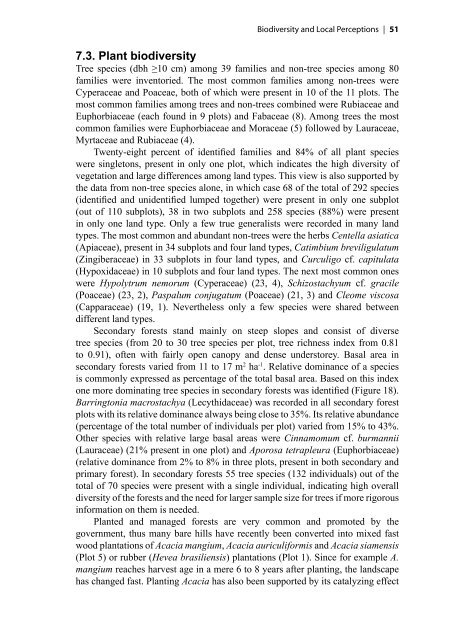English 2.28MB - Center for International Forestry Research
English 2.28MB - Center for International Forestry Research
English 2.28MB - Center for International Forestry Research
You also want an ePaper? Increase the reach of your titles
YUMPU automatically turns print PDFs into web optimized ePapers that Google loves.
Biodiversity and Local Perceptions |<br />
7.3. Plant biodiversity<br />
Tree species (dbh ≥10 cm) among 39 families and non-tree species among 80<br />
families were inventoried. The most common families among non-trees were<br />
Cyperaceae and Poaceae, both of which were present in 10 of the 11 plots. The<br />
most common families among trees and non-trees combined were Rubiaceae and<br />
Euphorbiaceae (each found in 9 plots) and Fabaceae (8). Among trees the most<br />
common families were Euphorbiaceae and Moraceae (5) followed by Lauraceae,<br />
Myrtaceae and Rubiaceae (4).<br />
Twenty-eight percent of identified families and 84% of all plant species<br />
were singletons, present in only one plot, which indicates the high diversity of<br />
vegetation and large differences among land types. This view is also supported by<br />
the data from non-tree species alone, in which case 68 of the total of 292 species<br />
(identified and unidentified lumped together) were present in only one subplot<br />
(out of 110 subplots), 38 in two subplots and 258 species (88%) were present<br />
in only one land type. Only a few true generalists were recorded in many land<br />
types. The most common and abundant non-trees were the herbs Centella asiatica<br />
(Apiaceae), present in 34 subplots and four land types, Catimbium breviligulatum<br />
(Zingiberaceae) in 33 subplots in four land types, and Curculigo cf. capitulata<br />
(Hypoxidaceae) in 10 subplots and four land types. The next most common ones<br />
were Hypolytrum nemorum (Cyperaceae) (23, 4), Schizostachyum cf. gracile<br />
(Poaceae) (23, 2), Paspalum conjugatum (Poaceae) (21, 3) and Cleome viscosa<br />
(Capparaceae) (19, 1). Nevertheless only a few species were shared between<br />
different land types.<br />
Secondary <strong>for</strong>ests stand mainly on steep slopes and consist of diverse<br />
tree species (from 20 to 30 tree species per plot, tree richness index from 0.81<br />
to 0.91), often with fairly open canopy and dense understorey. Basal area in<br />
secondary <strong>for</strong>ests varied from 11 to 17 m 2 ha -1 . Relative dominance of a species<br />
is commonly expressed as percentage of the total basal area. Based on this index<br />
one more dominating tree species in secondary <strong>for</strong>ests was identified (Figure 18).<br />
Barringtonia macrostachya (Lecythidaceae) was recorded in all secondary <strong>for</strong>est<br />
plots with its relative dominance always being close to 35%. Its relative abundance<br />
(percentage of the total number of individuals per plot) varied from 15% to 43%.<br />
Other species with relative large basal areas were Cinnamomum cf. burmannii<br />
(Lauraceae) (21% present in one plot) and Aporosa tetrapleura (Euphorbiaceae)<br />
(relative dominance from 2% to 8% in three plots, present in both secondary and<br />
primary <strong>for</strong>est). In secondary <strong>for</strong>ests 55 tree species (132 individuals) out of the<br />
total of 70 species were present with a single individual, indicating high overall<br />
diversity of the <strong>for</strong>ests and the need <strong>for</strong> larger sample size <strong>for</strong> trees if more rigorous<br />
in<strong>for</strong>mation on them is needed.<br />
Planted and managed <strong>for</strong>ests are very common and promoted by the<br />
government, thus many bare hills have recently been converted into mixed fast<br />
wood plantations of Acacia mangium, Acacia auriculi<strong>for</strong>mis and Acacia siamensis<br />
(Plot 5) or rubber (Hevea brasiliensis) plantations (Plot 1). Since <strong>for</strong> example A.<br />
mangium reaches harvest age in a mere 6 to 8 years after planting, the landscape<br />
has changed fast. Planting Acacia has also been supported by its catalyzing effect

















